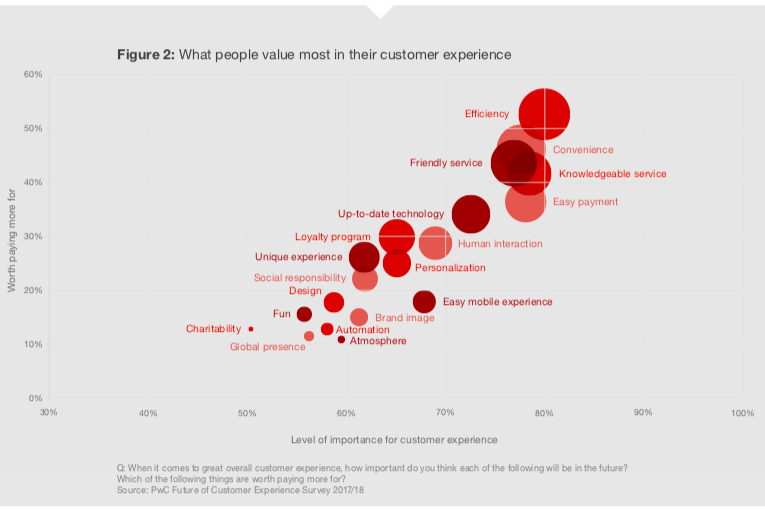See the summarization of PwC Customer Experience Report and identify the next few issues you’ll target to take your team to the next level.
Quality customer service minimizes conflict, allows your customers to feel heard, and gives you a way to connect with the people using your product. In 2018, companies need to compete on customer experience to keep their customer loyal. This is why we were so excited to see new research into what consumers really want when it comes to a great customer experience.
In this article, we summarize PwC’s Future of Customer Experience report and provide tips on how customer support managers can use this information to improve their own operations.
PwC’s Future of Customer Experience Report
According to PwC’s customer experience report, when making purchasing choices, price and quality remain at the top of all considerations, however interactions and positive experiences with the company rank third, so support is an important factor in an organization’s success.
Their findings, detailed below, expand on these key points:
- Your customers have demands. They aren’t what you think.
- Customers generate revenue. Employees drive the experience.
- Technology isn’t the final solution, it’s an enabler.
Methodology: To create the report, PwC surveyed a representative sample of 15,000 people from 12 countries. 4,000 of the respondents were from the United States, while the remaining 11,000 were from a sampling of countries around the world. The surveys were done both online and as in-person interviews.
Here’s what they discovered:
Know What Matters to Consumers
According to 80% of those customers surveyed, the essential elements of positive customer experiences are:
- Speed.
- Convenience.
- Knowledgeable help and friendly service.
Customers value user-friendly interfaces and do not want to sacrifice speed for design or automation. They expect technology to work and are quickly frustrated when it doesn’t.
What Customer Support Managers Need to Know:
Considering the top three elements above, how does your support stack up? Are you staffed appropriately to achieve the speedy replies users expect? Are your customers able to quickly locate where to get help? Is your team well-trained and happy?
Technology Isn’t Everything
Almost half (48%) of consumers in the U.S. consider friendly, welcoming service a sign of success in an industry. Fewer respondents (only 32%) pointed to having the most up-to-date technology a sign of success. People often only link technology and customer experience when something has gone wrong.
In the chart below, you’ll notice things like “friendly service” and “efficiency” rank much higher than automation.
Figure 1: What people value most in their customer experience
What Customer Support Managers Need to Know:
Regardless of the technology you’re using to support your customers, make sure the human element of the support you’re providing is top-notch. Continue to grow your workforce’ skill-set and their ability to address customer needs, no matter which tool they’re using to communicate with users.
Survey shows that your users are more invested in the way your team interacts with them than if you’ve got the latest tool in place.
One Chance To Get It Right
According to the survey, 59% of U.S. customers will take their business to a competitor after several bad experiences, with 17% leaving after only one negative experience. If you serve customers in Latin America, the number of people who will leave after one bad experience is 49%.
When your customers feel heard and appreciated, you can not only save the current situation, but also have a chance at earning more of their spending dollars in the future.
The chart below shows when customers are likely to leave due to poor support experiences. While the numbers vary, you’ll notice they’re all higher than the number of customers you want to lose because of your team.
Figure 2: When do consumers stop interacting with a brand they love?
What Customer Support Managers Need to Know:
Imagine losing 20-50% of your customers in one day due to poor, inadequate support. What does your team do now when an interaction goes wrong? Do you have the appropriate systems in place to follow up and make it right?
Consider how you can improve this for the customer, and also how you can reduce these instances through training and culture improvements for your staff.
Earn Their Data
PwC found “when customers truly value a service, 63% are willing to share more data with your company.” On the flipside, “43% of U.S. consumers say they would not give companies permission to collect their personal data (such as location, age, lifestyle, preferences and purchase history) to allow for more personalized, customized experiences.”
What Customer Support Managers Need to Know:
If your business needs access to private customer data for success, customer support is important!
How can you build trust and a perception of quality so your users are more comfortable sharing data with you? Beyond protecting private customer data, support teams can work to increase customer satisfaction to earn your customers’ willingness to share more of their personal information.
Build Loyalty
Feeling appreciated results in U.S. customers being “more likely to recommend or endorse a brand on social media, subscribe to a brand’s newsletter or sign up for promotions and make repeat purchases.”
Further, they’re likely to spend more on your products or services with quality customer support.
Customer loyalty is essential, and support teams are pivotal in increasing or decreasing it.
What Customer Support Managers Need to Know:
When it comes to customer loyalty, your support team can make an impact by focusing on ensuring positive interactions with customers as often as possible. Simply put, make sure your team is providing high-quality support and has the tools to keep doing that in the future. Review customer feedback regularly and address the issues you identify through training, staffing adjustments, and company culture improvements.
Be (Or Feel) More Human
While automation has become more common and American consumers are adjusting to encountering it more often, they want to talk to a person as soon as something goes wrong. According to the survey, “only 3% of U.S. consumers, for instance, want their experiences to be as automated as possible” and 71% of Americans still prefer to interact with a human instead of a bot.
In the chart below, you’ll see that people around the world don’t expect quality customer support to be handled solely by machines.
Figure 3: Once technology becomes advanced we won’t need people for great customer experiences
What Customer Support Managers Need to Know:
If you want to take advantage of automation and chatbots, go for it! But make sure you’ve got humans in place to help as soon as they’re needed. A combination of both allows your support team to focus on providing the best support they can for the more complex problems, while the automated system handles the easier bits.
After implementing automation, if you currently measure performance using the number of interactions, you’ll need to adjust, as the interactions per person should decrease, while the difficulty level is likely to increase. Instead, consider tracking successful solutions.
Also, if you haven’t lately, take a look at the tone your support team deploys in communicating with users. If your organization tends to be more serious and strictly professional in its wording, consider trying out a more friendly, approachable chat style to allow your users to feel the humanity of your team come through in your messages.
Empower Your Employees
Don’t frustrate your customers unnecessarily. It’s important to make sure your team knows the product inside and out and can support it well. The survey found that:
- 46% of all consumers will abandon your brand if employees are not knowledgeable.
- Only 38% of U.S. consumers say the customer support team members they interact with understand their needs.
The top five reasons customers say they’re driven away are things support teams can directly impact:
- Bad employee attitude
- Unfriendly service
- Untrusted company
- Unknowledgeable employees
- Inefficiency
The chart below displays additional reasons customers say they’re compelled to take their business elsewhere.
Figure 4: What drives people away
What Customer Support Managers Need to Know:
Consider the Ritz-Carlton’s policy to allow their employees to spend up to $2,000 to improve a bad experience for a guest. While it may not make sense for your company to offer such an extravagant budget for saving a user experience, you can implement your own version of this policy by empowering your employees to make things right.
For example, instead of having a particular group for issuing refunds, why not let any customer service representative handle basic billing issues?
Empowering your team has two immediate benefits: they can help your customer find a happy solution more quickly, instead of transferring them elsewhere, and your team members feel trusted to decide the best way to resolve an issue.
Take Action
While you may be satisfied with how you’re addressing a few issues found in the report, there are probably a few you know your team could work to improve. Download your own copy of the full PwC 2018 Future of Customer Experience Report and identify the next few issues you’ll target to take your team to the next level.













